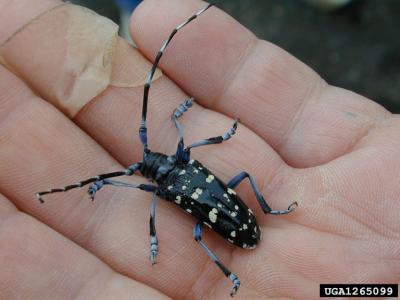
The citrus longhorned beetle (CLB) is a close relative of the Asian longhorned beetle. CLB attacks hosts in more than 100 species in 36 families, including maple (Acer), oak (Quercus), willow (Salix), poplar (Populus), apple (Malus), and citrus trees (Citrus) (note: for a more comprehensive host list, see the bottom of this article). The ability of the insect to complete its development has not been confirmed for all purported hosts (Haack et al. 2009). The larvae are very large, around 5 cm (2 inches) in length, and bore numerous tunnels in the trunk that sever internal transport and can eventually kill the tree, in addition to making it susceptible to wind breakage.
Introductions – almost always on miniaturized trees (bonsai or penjing) – began to be reported around the year 2000 in North America (Georgia in 1999; Thomas, 1999; Washington 2001) and Europe (Italy and Netherlands in 2000; EPPO). While most interceptions and introductions have been associated with imports of miniaturized maples (Acer), the Georgia interceptions were on crepe myrtle (Lagerstroemia) (UF/IFAS).
Introductions to Europe on imported miniaturized trees also occurred; 24 interceptions were reported in 2008, although the reasons for this uptick are not clear (Haack et al. 2009). European countries reporting interception after 2003 include Croatia, Germany, Guernsey, Italy, Netherlands, Switzerland, Turkey, and United Kingdom (EPPO). Eradication has proved difficult in Europe. Croatia, France, Germany, and Italy have all reported recent detections of citrus longhorned beetle (EPPO); it is often not clear whether these outbreaks have persisted from earlier introductions, or represent new introductions.
The insect was intercepted in Chinese shipments of bonsai plants to Georgia (USA) in 1999 (Thomas, 1999). The first infestation of citrus longhorned beetles was discovered in 2001 on quarantined, imported maple trees in a plant nursery in Tukwila, Washington (Anonymous, 2002). Examination of the damage raised suspicions that up to five beetles had escaped. Correspondingly, the Washington State Department of Agriculture imposed a quarantine of properties within one-half mile of the point of introduction. During the summer of 2001, APHIS and the Washington State Department of Agriculture cut and chipped 1,000 trees in hopes of eradicating this dangerous pest (USDA APHIS, 2002; J. Lundberg, pers. comm., 2004). It was declared eradicated in 2006 (WISC 2021). The risk rating for this beetle is very high, and professionals believe that if it becomes established, the impact of this insect could be greater than the more widely known Asian longhorned beetle.
While the great majority of shipments transporting the citrus longhorned beetle have been from China, citrus longhorned beetle larvae have also been intercepted in shipments from Japan and Korea. In response, APHIS has prohibited imports of maples, elms, and other genera from China, Japan, and Korea through its Not Authorized for Importation Pending Pest Risk Assessment (NAPPRA) program. Korea has petitioned APHIS to relax this prohibition, so far without success.
USFS scientists and managers developed a conservation priority-setting framework for forest tree species at risk from pest & pathogens and other threats. The Project CAPTURE (Conservation Assessment and Prioritization of Forest Trees Under Risk of Extirpation) uses FIA data and expert opinion to group tree species under threat by non-native pests into vulnerability classes and specify appropriate management and conservation strategies. The scientists prioritized 419 tree species native to the North American continent. The analysis identified 15 taxonomic groups requiring the most immediate conservation intervention because of the tree species’ exposure to an extrinsic threat, their sensitivity to the threat, and their ability to adapt to it. Each of these 15 most vulnerable species, and several additional species, should be the focus of both a comprehensive gene conservation program and a genetic resistance screening and development effort. The citrus longhorned beetle is not known to be a threat to any of these 15 most vulnerable species.
For more information, visit: USFS Pacific Northwester Region Success Story – Citrus Longhorned Beetle or https://invasivespecies.wa.gov/accomplishment/asian-and-citrus-long-horned-beetle/
Summary of Hosts of Citrus Longhorned Beetle: Hosts include maples (Acer), silk tree (Albizzia), alders (Alnus), birch (Betula), Camellia, hickory/pecan (Carya), chestnut (Castanea), Japanese cedar (Cryptomeria), wild olive (Elaeagnus), loquat (Eriobotrya japonica), beech (Fagus), fig (Ficus), ash (Fraxinus), mallow (Hibiscus), holly (Ilex), walnut (Juglans), spicebush (Lindera), amur (Maackia), mulberry (Morus), Photinia, sycamore/plane tree (Platanus), trifoliate orange (Poncirus trifoliata), poplars (Populus), cherry/peach/apricot/plum (Prunus), firethorn (Pyracantha), pears (Pyrus), oaks (Quercus), sumac (Rhus), locust (Robinia), rose (Rosa), blackberry/raspberry (Rubus), willows (Salix), pagoda tee (Sophora), Stransvaesia, snowbell tree (Styrax), and elm (Ulmus) (UF/IFAS). In Asia, pines might also be hosts (Haack et al. 2009). In Italy, sugar maple (Acer saccharinum) trees have been heavily attacked and killed [CABI].
Sources
Anonymous, 2002. Citrus longhorned beetle eradication project. Washington’s Tree Slayer (PDF has been removed since initial citation, similar information now found at: https://www.fs.usda.gov/detail/r6/forest-grasslandhealth/invasivespecies/?cid=fsbdev2_027207 author listed as David Bridgwater, USFS Retired).
CABI https://www.cabi.org/isc/datasheet/5556 accessed autumn 2020
European and Mediterranean Plant Protection Organization. A2 pest list https://www.eppo.int/ACTIVITIES/plant_quarantine/A2_list (accessed January 2021)
Haack, R.A., F. Herard, J. Sun, J.J. Turgeon. 2009. Managing Invasive Populations of Asian Longhorned Beetle and citrus Longhorned Beetle: A Worldwide Perspective. Annu. Rev. Entomol. 2010.55:521-46
Lundberg, John. June 2004. Washington State Department of Agriculture, P.O. Box 42560, Olympia, WA 98504-2560, personal communication.
Potter, K.M., Escanferla, M.E., Jetton, R.M., Man, G., Crane, B.S., Prioritizing the conservation needs of US tree spp: Evaluating vulnerability to forest insect and disease threats, Global Ecology and Conservation (2019), doi: https://doi.org/10.1016/
Thomas, M. 1999. Pest Alert: Citrus longhorned beetle. https://www.doacs.state.fl.us/pi/enpp/ento/clbalert.htm, accessed July 2004.
United States Department of Agriculture, Animal Plant Health Inspection Service. 2002. Citrus longhorned beetle program. King County, Washington. Environmental Assessment. April, 2002. USDA, APHIS, 12 pp.
University of Florida Institute of Food and Agricultural Sciences. 2018. https://entnemdept.ufl.edu/creatures/trees/beetles/citrus_longhorned_beetle.htm
Washington Invasive Species Council, WISC, accessed January 2021. https://invasivespecies.wa.gov/accomplishment/asian-and-citrus-long-horned-beetle/



